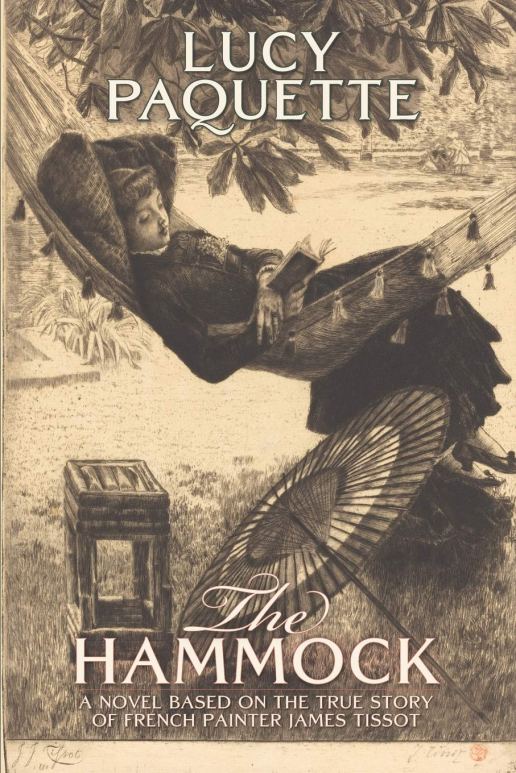To cite this article: Paquette, Lucy. “James Tissot’s Model and Muse, Kathleen Newton.” The Hammock. https://thehammocknovel.wordpress.com/2017/07/13/james-tissots-model-and-muse-kathleen-newton/. <Date viewed.>
Kathleen Irene Ashburnham Kelly Newton (1854 – 1882) first appeared in James Tissot’s paintings in 1876. Who was she? All we have to know her by are a few biographical facts researched by Tissot scholar Willard E. Misfeldt (b. 1930) and others, and dozens of paintings of Kathleen Newton by James Tissot.
According to Dr. Misfeldt, Kathleen Irene Kelly was born in May or June of 1854 in Agra, India. Her mother, Flora W. Boyd, passed away, and she and her brother, Frederick, and elder sister, Mary Pauline (“Polly,” 1851/52 – 1896), were the responsibility of their father, Charles Frederick Kelly (1810 – 1885). Mr. Kelly had been employed at the accountant’s office of the British East India Company in Agra from age 21 or 22 until his retirement to Conisbrough, South Yorkshire, in 1866. At some point around mid-1860, the family began to use Ashburnham as a middle name. Kathleen and Mary Pauline were sent back to England to be educated at Gumley House Convent School, Isleworth. When Kathleen was sixteen, a marriage was arranged for her, and she returned to India to marry Dr. Isaac Newton, a surgeon in the Indian civil service.
Dr. Misfeldt skirts the issue of what happened next, but after the wedding on January 3, 1871, the young bride is said to have followed the advice of the local priest and confessed to her new husband that while travelling on the ship to India, she had been involved with a Captain Palliser. She was sent back to England, gave birth to a daughter, Muriel Violet Mary Newton, in Conisbrough on December 20, and was officially divorced (decree nisi) by December 30. At some point, she moved in with her sister Polly, by then married and living with her two young daughters, Belle and Lilian, at 6 Hill Road, St. John’s Wood, London. There Kathleen gave birth to a son, Cecil George Newton, on March 21, 1876. (It is said that Polly’s husband, Mr. Hervey, was in the Indian civil service.)
James Tissot had left Paris following the bloody Commune in 1871, and by early 1873, he had bought the lease on a medium-sized, two-storey Queen Anne-style villa, built of red brick with white Portland stone dressing, at 17 (now 44), Grove End Road, St. John’s Wood.
The residents of the comfortable suburban homes around the Regent’s Park and the district of St. John’s Wood, west of the park, were merchants, bankers and lawyers. Tissot’s house was set in a large and private garden separating him from the horse traffic, omnibuses and pedestrians on their way to the park or the still-new Underground Railway station nearby. Kathleen lived just around the corner, and legend has it that she met Tissot while mailing a letter at a postbox.
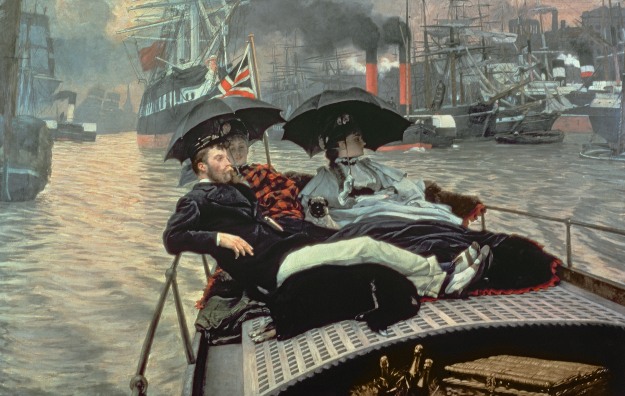
On the Thames (1876), by James Tissot. Oil on canvas, 28.5 by 46.5 in. (72.5 by 118 cm). Hepworth Wakefield Art Gallery, Wakefield, UK. Courtesy of The Bridgeman Art Library for use in “The Hammock: A novel based on the true story of French painter James Tissot” by Lucy Paquette, © 2012.
In my previous blog post, James Tissot’s Models à la Mode, I indicated that the shadowy face in the center of The Thames (1876), was likely Tissot’s first painting featuring Kathleen Newton, and that she seems to be the model for one of the figures in Portsmouth Dockyard (c. 1877) as well.
Kathleen modeled for dozens of Tissot’s paintings; soon, he was painting her almost exclusively. These pictures form a charming chronicle of their years together. They also portray her rapid evolution from a young beauty travelling with her artist-lover, to a busy, beloved mother, then to a woman struggling with tuberculosis.
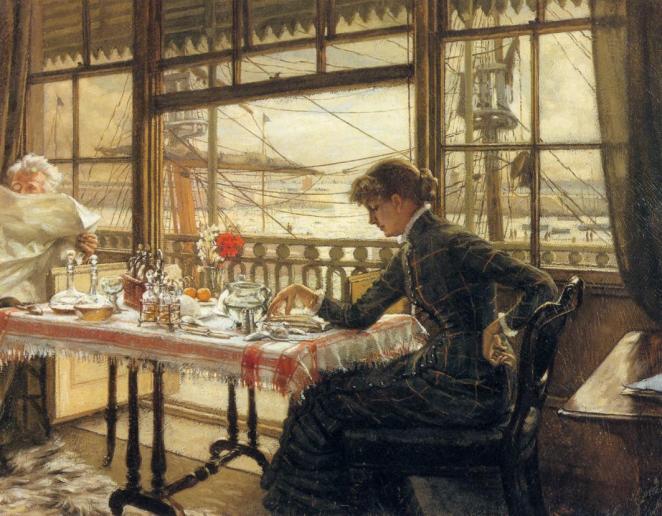
In Room Overlooking the Harbor (c. 1876-78) Kathleen is on holiday with Tissot. He captured her going about her business while an older man (who could be a servant accompanying the couple) gamely models as well.
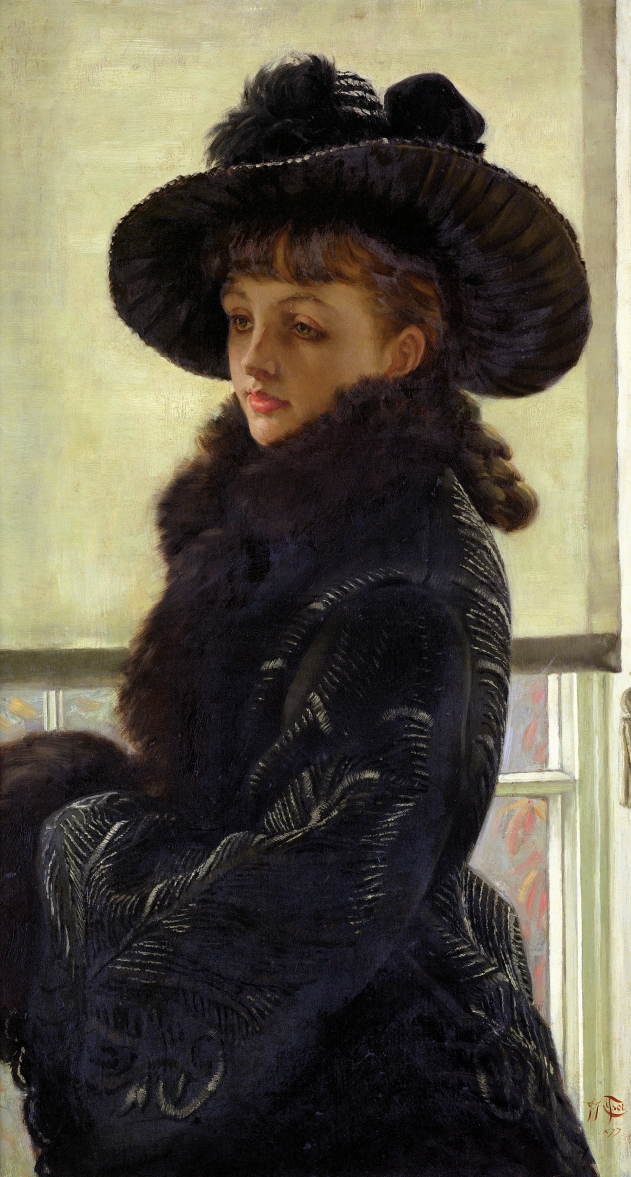
Mavourneen (Portrait of Kathleen Newton, 1877). Oil on canvas, 36 in. /91.44 cm. by 20 in./50.80 cm. Photo courtesy of The Bridgeman Art Library for use in “The Hammock: A novel based on the true story of French painter James Tissot,” © 2012 by Lucy Paquette
In 1877, Tissot captured Kathleen’s youthful, glowingly healthy beauty in Mavourneen.
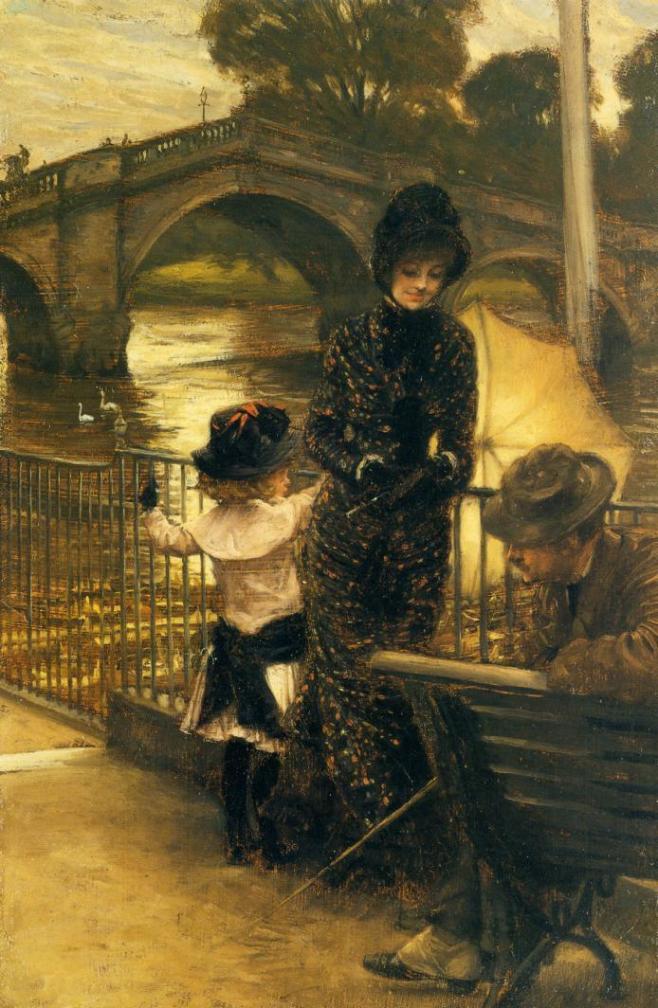
In By the Thames at Richmond (c. 1878), a scene based on a photograph that surely was staged, a man (modeled by Tissot or perhaps Kathleen’s brother, Frederick Kelly) is writing “I love you” on the ground while Kathleen reacts with a smile. The girl is likely Kathleen’s daughter, Muriel Violet, who would have been about seven years old at this time.
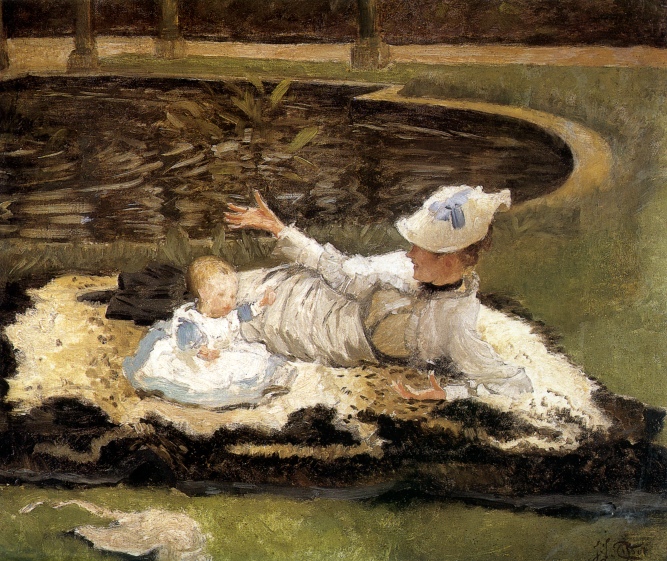
Study for “Mrs. Newton with a Child by a Pool” (c. 1877-78). Virginia Museum of Fine Arts, Richmond, Virginia, USA.
In Mrs. Newton with a Child by a Pool (c. 1877-78), Kathleen plays with her son, Cecil, by the ornamental pool in the garden of Tissot’s house in St. John’s Wood.
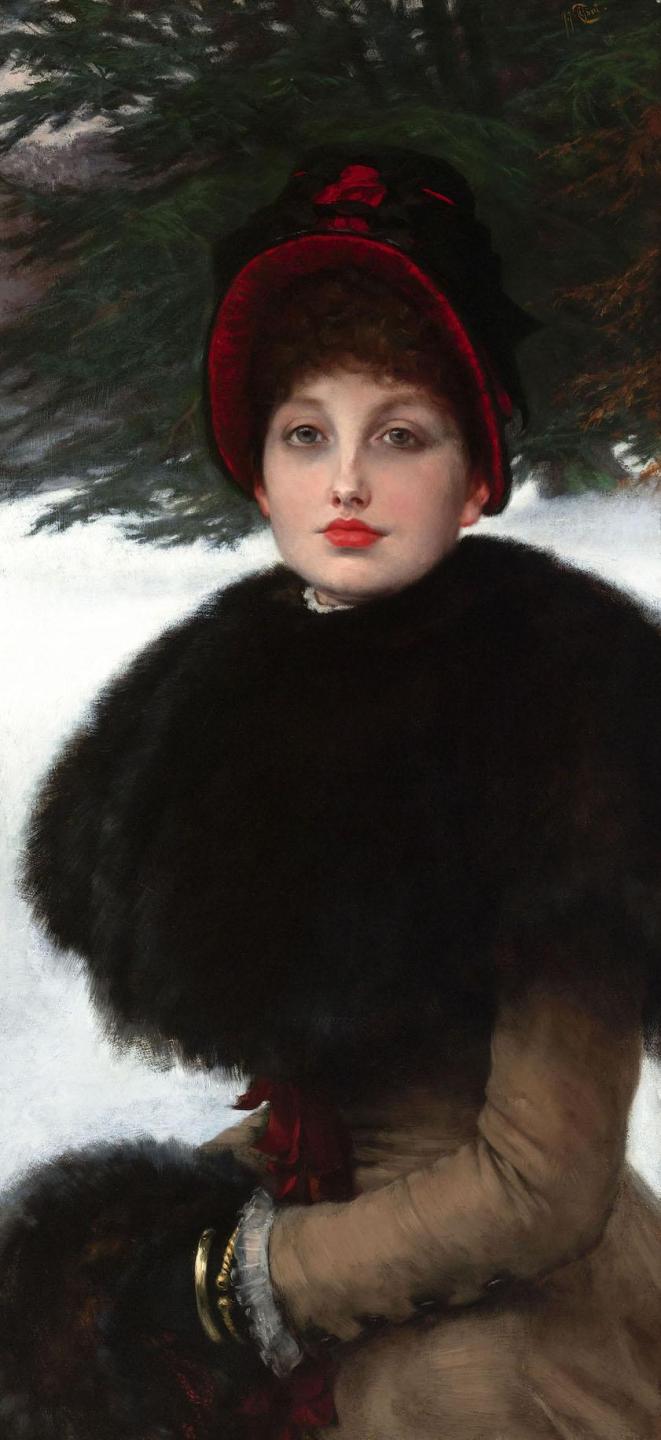
Kathleen is a lovely 24-year-old in A Winter’s Walk (Promenade dans la neige, c. 1878).
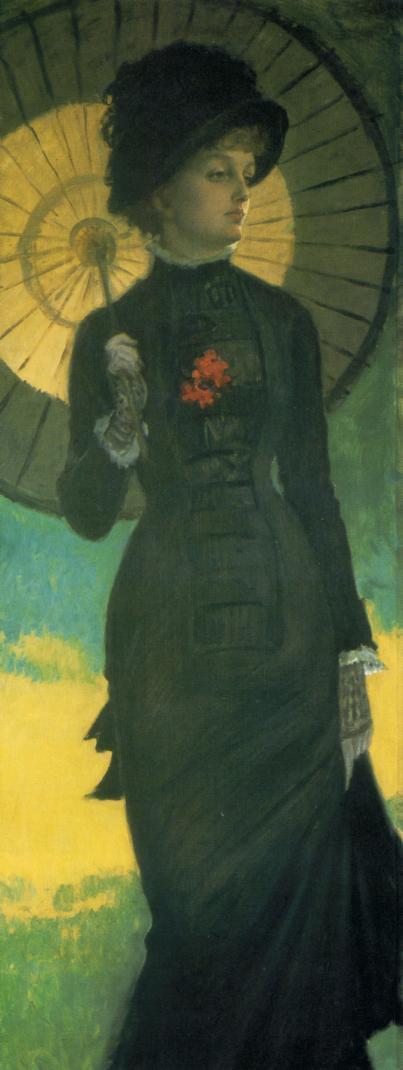
She is still fresh-faced at 25 in Mrs. Newton with an Umbrella (c. 1879, Musée Baron Martin, Gray, France).
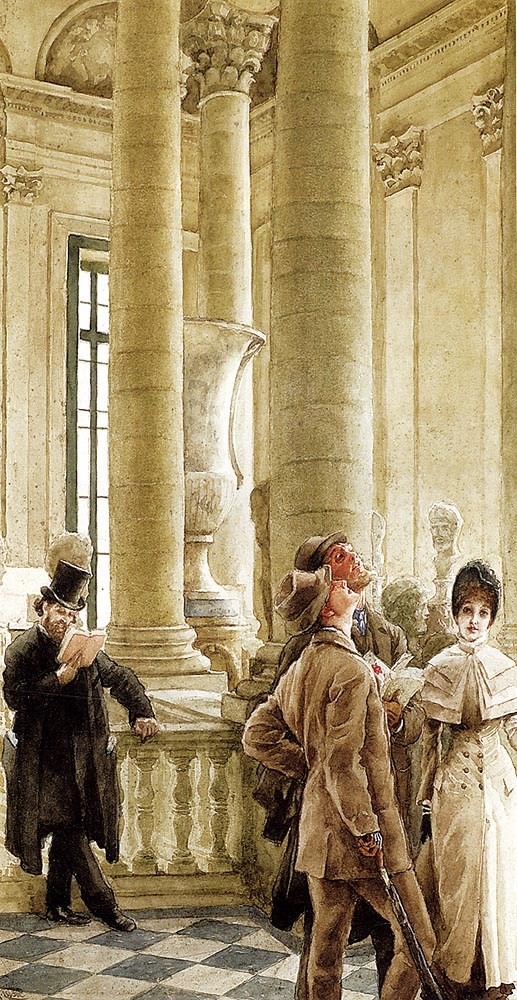
At the Louvre (c. 1879-80), by James Tissot. Private Collection. (Photo: Wikiart.org)
In 1879, the couple traveled to Paris, where Tissot used the Louvre as a setting for several paintings featuring Kathleen in her caped greatcoat.
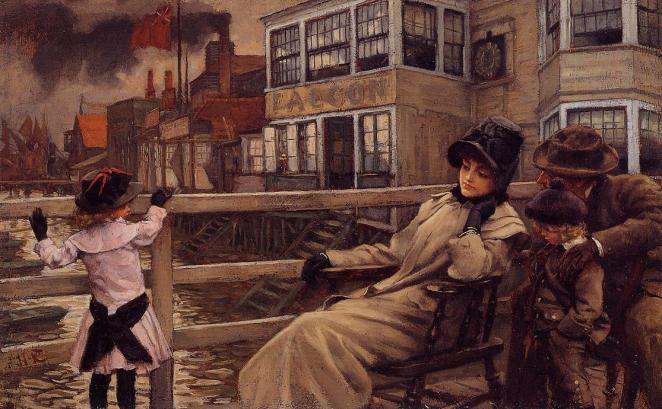
Waiting for the Ferry (c. 1878), by James Tissot.
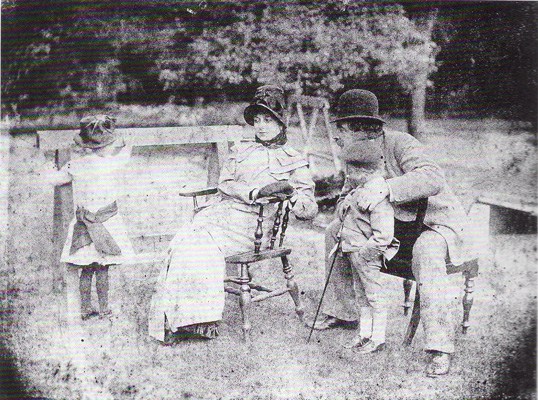
Kathleen Newton with James Tissot in his garden at Grove End Road. The children are Muriel Violet Newton and Cecil Newton. Photo c. 1878. (Wikimedia.org)
Between about 1878 and 1881, Tissot produced a number of paintings featuring Kathleen as a traveler. [See The Art of Waiting, by James Tissot, Tissot and Degas visit the Louvre, 1879 and Victorians on the Move, by James Tissot.] Tissot had painted Kathleen Newton so often in the half-dozen years they spent together that her face became stylized.
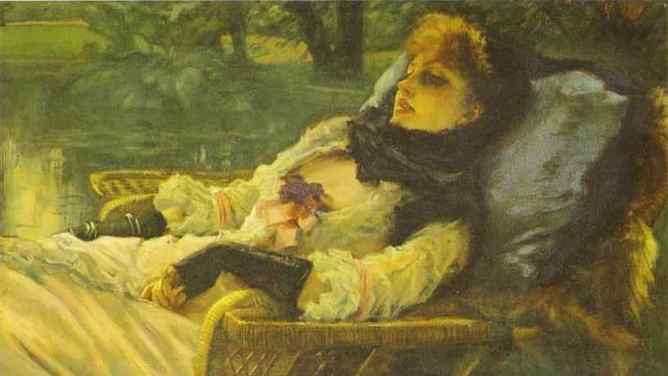
The Dreamer (or, Summer Evening, c. 1882), by James Tissot. Oil on canvas. Musée d’Orsay, Paris. (Photo: Wikiart.org)
In the final two years of Kathleen’s life, Tissot captured her looking tired and pale, with dark shadows under her eyes, or bedridden. [See James Tissot’s garden idyll & Kathleen Newton’s death.] The Victorian Web features a study of Mrs. Newton asleep in a conservatory chair, courtesy of Peter Nahum Ltd, London, dated 1881-82, and the Musée Baron Martin in Gray, France has a painting from the same time period, Mrs. Newton Resting on a Chaise-longue, in which she is propped up on two pillows and looks very ill.
Kathleen Newton died of tuberculosis on November 9, 1882, at age 28, at Tissot’s house with her sister, Polly Hervey, at her side (according to the death register). Tissot draped the coffin in purple velvet and prayed beside it for hours.
In the six years that Kathleen Newton lived with James Tissot and modeled for him, he painted few other female models besides the girl in Croquet (c. 1878). He produced only about two major portraits during the years Kathleen lived with him, Algernon Moses Marsden (1877), and Portrait of Mrs Catherine Smith Gill and Two of her Children (1877, Walker Art Gallery, Liverpool.)
Immediately after the funeral on November 14, at the Church of Our Lady in Lisson Grove, St. John’s Wood, Tissot returned to Paris. There, he exerted himself to re-establish his reputation in Paris with a series of fifteen large-scale pictures called La Femme à Paris (The Parisian Woman). Painted between 1883 and 1885, they portrayed the fashionable parisienne in various incarnations. Exhibited at the Galerie Sedelmeyer, from April 19 to June 15, 1885, as “Quinze Tableaux sur la Femme à Paris,” the pictures were poorly received. A critic for La Vie Parisienne complained that the women in the series were “always the same Englishwoman” – some say the faces all resemble Kathleen Newton. [See Tissot’s La Femme à Paris series.]
Tissot’s relationship with Kathleen Newton was evidently the only successful romance of his life. [See Tissot’s Romances.]
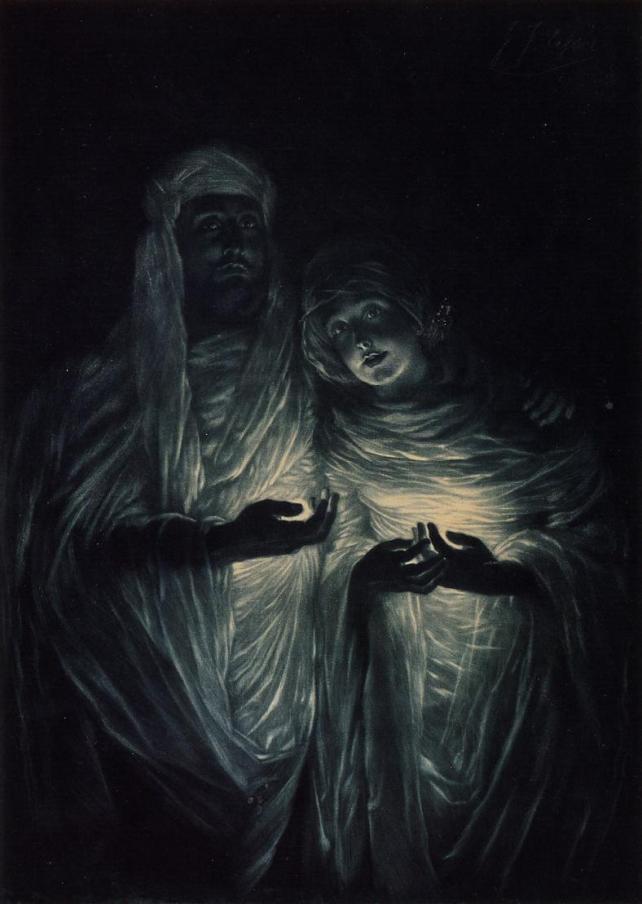
The Apparition (1885), by James Tissot. (Wikipaintings.org)
He tried to contact her through a series of séances. On May 20, 1885, at a séance in London, Tissot recognized the female of two spirits who appeared as Kathleen, and he asked her to kiss him. The spirit is said to have done so, several times, with “lips of fire.” Then she shook hands with Tissot and disappeared. He made this image of the vision to commemorate their reunion.
After his death in 1902, James Tissot and his work, and Kathleen Newton, were largely forgotten.
By 1930, few, if any, of Tissot’s contemporaries remained to share recollections of the artist. The only biographical material on Tissot publicly available was a twenty-five page journal article published in France in 1906.
Kathleen’s daughter, Muriel Violet, died in 1933, and Mrs. Newton’s identity was forgotten – except by her son, Cecil. In 1933, the first exhibition of Tissot’s work was held at the Leicester Galleries in London in 1933: ” ‘In the Seventies’ – An Exhibition of Paintings by James Tissot.” A visitor to this exhibition, a man in his late fifties, stood before one of the paintings of a beautiful woman and declared, “That was my mother,” then walked out. The woman, who appeared in a number of Tissot’s paintings between 1876 and 1882, and whose identity remained unknown into the next decade, was referred to as “la Mystérieuse” – the Mystery Woman.
The first biography was published in London in 1936: Vulgar Society: The Romantic Career of James Tissot, 1836-1902, by novelist and fashion historian James Laver (1899 –1975). Laver may have taken some poetic license when he wrote that Tissot kept his mistress hidden away in his home in St. John’s Wood and that “she led almost the life of a prisoner,” “as if she had been a beauty of the harem.”
In 1946, a London journalist, Marita Ross, published a plea for information regarding “La Mystérieuse,” Tissot’s unidentified mistress. But Lilian Hervey, then 71, replied that this was her aunt, Kathleen Irene Ashburnham Kelly Newton (1854 – 1882), and she had original photographs of Mrs. Newton with James Tissot. [See James Tissot in the 1940s: La Mystérieuse is identified.]
By the late 1960s, Willard Misfeldt was researching James Tissot and Kathleen Newton.
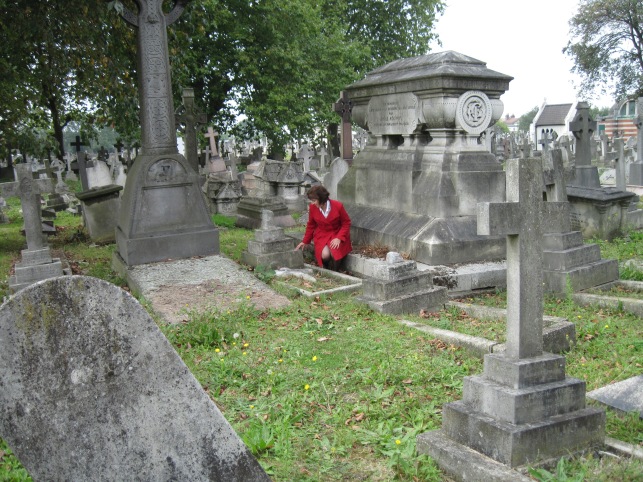
In 2014, I visited James Tissot’s one-time home in St. John’s Wood and Kathleen Newton’s grave. [See A visit to James Tissot’s house & Kathleen Newton’s grave.]
I was able to make arrangements for a private tour of Tissot’s home thanks to the kindness of Irish author Patricia O’Reilly. Patricia imagined Kathleen Newton’s life in A Type of Beauty: The Story of Kathleen Newton (1854-1882), © 2010 (cover photo, below left, courtesy of the author). Click here to read it – and click here to read how I’ve imagined Kathleen’s life in The Hammock: A novel based on the true story of French painter James Tissot ), © 2012!
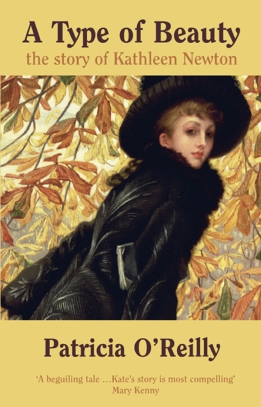
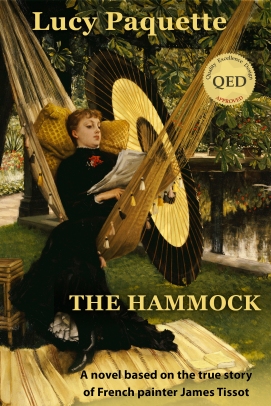
Related posts:
James Tissot’s house at St. John’s Wood, London
Was Cecil Newton James Tissot’s son?
James Tissot’s garden idyll & Kathleen Newton’s death
Kathleen Newton by James Tissot: eight auctioned oil paintings
© 2017 by Lucy Paquette. All rights reserved.
The articles published on this blog are copyrighted by Lucy Paquette. An article or any portion of it may not be reproduced in any medium or transmitted in any form, electronic or mechanical, without the author’s permission. You are welcome to cite or quote from an article provided you give full acknowledgement to the author.
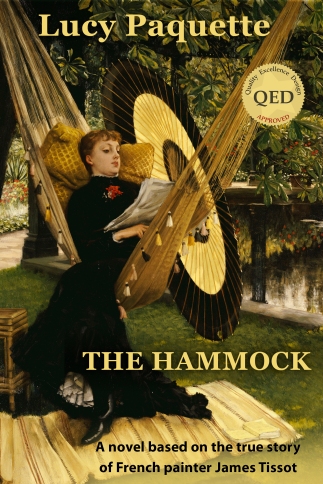 If you do not have a Kindle e-reader, you may download free Kindle reading apps for PCs, Smartphones, tablets, and the Kindle Cloud Reader to read The Hammock: A novel based on the true story of French painter James Tissot. Read reviews.
If you do not have a Kindle e-reader, you may download free Kindle reading apps for PCs, Smartphones, tablets, and the Kindle Cloud Reader to read The Hammock: A novel based on the true story of French painter James Tissot. Read reviews.
The Hammock: A novel based on the true story of French painter James Tissot, brings Tissot’s world from 1870 to 1879 alive in a story of war, art, Society glamour, love, scandal, and tragedy.
Illustrated with 17 stunning, high-resolution fine art images in full color
Courtesy of The Bridgeman Art Library
(295 pages; ISBN (ePub): 978-0-615-68267-9). See http://www.amazon.com/dp/B009P5RYVE.
The Hammock: A novel based on the true story of French painter James Tissot is now available as a print book – a paperback edition with an elegant and distinctive cover by the New York-based graphic designer for television and film, Emilie Misset.
